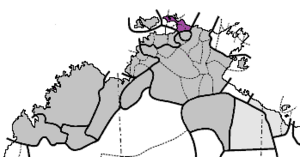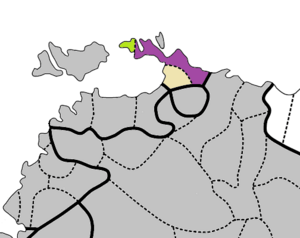Iwaidjan languages facts for kids
Quick facts for kids Iwaidjan |
|
|---|---|
| Geographic distribution: |
Cobourg Peninsula region, Northern Territory |
| Linguistic classification: | Arnhem Land?
|
| Subdivisions: |
Iwaidjic
|
 Iwaidjan languages (purple), among other non-Pama-Nyungan languages (grey)
|
|
 Closeup. Amurdag is the southern section (tan), Wurrugu the tip of the peninsula (green), the rest Iwaidjic (purple). On the grey island just offshore is Marrgu, once thought to be Iwaidjan.
|
|
The Iwaidjan or Yiwaidjan languages are a small group of Australian Aboriginal languages spoken in the Cobourg Peninsula area of the Northern Territory in Australia. These languages are special because they are "non-Pama–Nyungan," meaning they don't belong to the largest family of Aboriginal languages.
In 1997, a linguist named Nicholas Evans suggested that the Iwaidjan languages might be part of a bigger group called the Arnhem Land languages. However, not everyone agrees with this idea.
Contents
What are the Iwaidjan Languages?
The Iwaidjan language family is made up of a few different languages. The main branches are Iwaidjic and Amurdag.
- Iwaidjic languages include:
- Iwaidja
- Garig † (This means it's no longer spoken)
- Ilgar †
- Manangkari †
- Maung
Garig and Ilgar are very similar, almost like two versions of the same language. Manangkari might also be a version of Maung.
- Amurdag † is the other main branch, but it is also no longer spoken.
Some languages, like Marrgu and Wurrugu, were once thought to be part of the Iwaidjan family. However, experts now believe they are quite different and might belong to their own separate language groups.
Where are These Languages Spoken?
As of 1998, about 150 people spoke Iwaidja in a community called Minjilang on Croker Island. They also spoke English, Kunwinjku, and Maung.
Maung was mainly spoken in the community of Warruwi on Goulburn Island. It also had about 150 speakers. Both Iwaidja and Maung were still being learned by children, which is a good sign for a language's future. More recent information suggests both languages now have around 200 speakers and are used daily by people of all ages.
Sadly, most of the other Iwaidjan languages are very close to disappearing forever. In 1998, Amurdak had only three speakers left. Garig and Ilgar together had only three speakers. However, some younger people are helping to translate old recordings of these languages. They hope to save them or even bring them back to life.
How Iwaidjan Languages Connect to Others
The Iwaidjan languages have borrowed words from other languages. They have words from Macassarese and Malay, which are languages from Indonesia.
Iwaidja and Maung have also borrowed many words from Kunwinjku. Kunwinjku is another Aboriginal language from Australia.
Even though the Iwaidjan languages share some features with other Aboriginal language families, it's not clear which ones they are most closely related to. Some experts think they might be part of a larger group called the Arnhem Land languages.
Iwaidjan Words
Here are some basic words from Maung, Iwaidja, and Amurdak. You can see how some words are similar and some are very different!
| gloss | Maung | Iwaidja | Amarag |
|---|---|---|---|
| man | arargbi | waːrgbi | awuɭaɭu |
| woman | waramuŋbig | woraidjba | wuraidbaru |
| head | wandji | bagal | iwulja |
| eye | won | jaɽ | waliwu |
| nose | mulu | mul | wiːl |
| mouth | ilagbiridj | ɽagbiridj | wiiŋara |
| tongue | ŋaɽalg | garalg | wiŋaril |
| stomach | gɔːrag | galal | aɖigu |
| bone | ijaɣig | gilir | igada |
| blood | maniŋog | maniŋul | maniŋul |
| kangaroo | aijaŋ | jilbuwi | malaijuwar |
| opossum | wundäru | muŋarg | waŋguwu |
| emu | waramundubu | ganguɽg | |
| crow | gɔragag | gumbulag | gubula |
| fly | molg | moɭg | mulgulg |
| sun | mowan | muwar | mänjidj |
| moon | gorana | guɽana | gurana |
| fire | juŋgu | gudjäli | gudjäli |
| smoke | wuŋain | guŋain | guŋaṉ |
| water | wobaidj | wobaidj | aɖawud |
See also
 In Spanish: Lenguas iwaidjanas para niños
In Spanish: Lenguas iwaidjanas para niños

